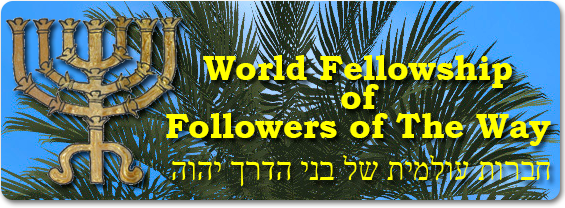Shalom everyone,
In preparation for the upcoming season of repentance, I thought it would be useful to explain the theological background to the process of Expiation – and not the modern Jewish understanding of it, but rather the original, ancient, pre-Exile, Yahwist Israelite understanding of it all. This is all part of the Massorite Talmidi mission to restore the best and most positive aspects of the original Israelite faith given to us at Sinai, but which have unfortunately been lost to us over the centuries, through times of exile and persecutions. Learning about the theology of the original Israelite Faith will strengthen us when we are missionised by Evangelicals.
We are all sadly familiar with the Paullist understanding about forgiveness and atonement, to the extent that ‘atonement’ has entered common western culture as meaning, ‘paying for one’s sins’. However, that is not what the process meant in the ancient Israelite religion. ‘Atonement’ is a specifically Christian word; the Yahwist equivalent is ‘expiation’. Expiation (kippur) is not about ‘paying the price’ for your sins – it’s all about being cleansed and purified from the harmful effects of your sins, once you have fully repented of them. Lev 16:30 explains the true significance of the Day of Expiations:
“for it is on this day that expiation shall be made for you to cleanse you; you will be made clean from all your sins before the presence of YHVH.”
In Paullist theology, they believe that the death of ‘Christ’ provides atonement for our sins. However, in Yahwist Israelite theology, it is the powerful fire of God’s Glory which cleanses us of our sins. Remember, ‘Glory’ in this context does not mean ‘splendour’ or ‘magnificence’. ‘Glory’ is an incredibly special power of God, which cleanses and purifies us of sin and evil. On Mt Horev, the Glory of YHVH passed by Moses. When he came back down the mountain, his face glowed, because the soul within him had been cleansed to the extent that his soul glowed within him.
Paullist theology says that it is at the point of atonement that a person is forgiven by God, but that is not how it is understood in Yahwist Israelite theology. God forgives our sins at the point of repentance – as soon as we genuinely repent of a sin, we are forgiven of that sin by God. However, there is something else going on that most modern theologians are not aware of.
When you commit a sin, you incur what is called ‘sin-guilt’ (Hebrew: אַשְׁמָה ashmah, eg Lev 4:3, 6:7). What this means is that the sin causes the life-force (nefesh) of one’s soul to become injured and blemished (you incur injury and damage to your life-force). It is this injury / blemish that is being removed and healed during the process of expiation, by the power of God’s Glory.
God forgives our sins at the moment of repentance. We then prepare ourselves through solemn prayer, so that the penitent soul can then go forward into the presence of God’s Glory, to have the blemish and injury of our sins healed. That is what expiation is.
The Tabernacle that was built in the wilderness had a copious amount of spiritual symbolism attached to it. The western half of the compound represented the heavenly realm, and the eastern half represented the earthly realm. At the very centre of the heavenly half was the Ark of the Covenant, where the powerful Glory of YHVH would appear between the wings of the Kheruvim on the lid or ‘expiation seat’ of the Ark. In the very centre of the earthly half was the altar of burnt-offering, intended to symbolise the throne and Glory of YHVH. The altar, when sin-offerings were offered upon it, was meant to symbolise what happened on earth, when God acted in heaven to cleanse us of our sins.
The blood of the sin-offering symbolised the injured life-force of the offerer, coming forward to be cleansed by the Glory of God, symbolised by the flames on the altar. It was NEVER the blood of the animal that provided expiation; that was purely meant as a symbol, during a time when the Israelites wrongly believed that sacrifices were necessary. It was ALWAYS the power of YHVH’s Glory that provided expiation for our sins – that is, the cleansing and purifying of our souls from the injury and blemish of sin, was accomplished by the power of YHVH’s Glory. Just as the flames on the altar completely consumed specific parts of the sin-offering after they had been removed from the body of the sacrificial offering, so too, the fire of YHVH’s Glory completely consumes our sins, removing them from our souls, until they are no more.
To summarise, when we sin, the life-force of our souls becomes injured and blemished. When we repent, God immediately forgives us of our sins. It is the very act of repentance and forgiveness, combined with prayer and reparative works, which then enables us to safely come into the presence of God’s Glory, without doing harm to our souls. The power of God’s Glory then restores our souls to their full health and wholeness. Expiation cleanses our souls, so that we are restored to the full, healthy functioning of our minds and souls.
Yom ha-Kippurim is not about paying the price of one’s sins (as Paul said), but rather, it’s about having the blemish and injury of one’s sins cleansed by the powerful fire of God’s Glory, so that we become a new being once more, as if we had never sinned in the first place:
“I – and I alone – am the One who blots out your transgressions for My own sake, and shall remember your sins no more” (Isa 43:2)
Blessings in the Name of YHVH our Healer
Your brother
Shmuliq
